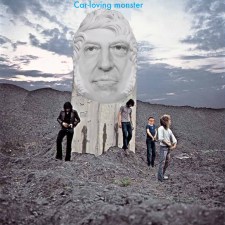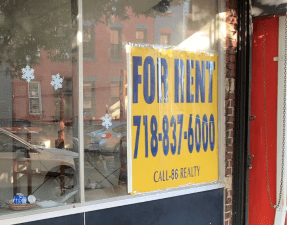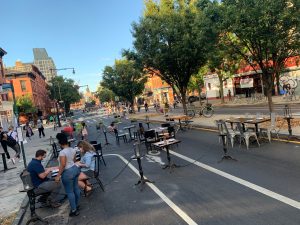De Blasio to Streetsblog: ‘I Want to Lighten the Burden on Car Owners’

Mayor de Blasio made one thing exceptionally clear in his press conference today: he does not want to burden car owners in any way.
The car-loving mayor made the comment one day after announcing an historic reduction in the number of days when car owners are required to move their privately owned vehicles from the public space along the curb so that the roadways can be properly cleaned. That announcement on Tuesday was in essence a handout to the small minority of New Yorkers who own cars and store them nightly, sometimes for days and days [pg, 26 here], on roadways that could be serving other transportation needs — specifically the moving of people.
“Guess what, Gersh, a lot of people still have cars,” the mayor said sarcastically when asked by this reporter why he was enabling car culture rather than seeking to break it.
First, Streetsblog’s question and then the mayor’s answer:
Streetsblog: Yesterday you made a pretty historic announcement about alternate-side-of-the-street parking, which will make it far easier for people to own cars in the city. Given all you’ve said over the last few weeks about how the future of the city must be less about the car and more about transit, why would you do something to make it easier and more convenient, and indeed cheaper, to own a car and store for it free on the street in New York City?
Mayor de Blasio: You are always ideologically consistent and I commend you. But I disagree with you. Respectfully, you sometimes present a world where there is only one factor, but there are multiple factors. I believe the future is mass transit and that is where we are going to focus our first energies for the future in terms of how people get around. And that’s what we’ve been doing … in terms of expansion of bus service, Select Bus Service, what we have added recently with the busways (which is historic), creating a citywide ferry system, the expansion of Citibike. All of that has to happen and more, and a year ago, it seems like ancient history, finally getting a mechanism to find the MTA and getting funding for our subways. … The glass is more than half full making this a city that would be more and more about mass transit.
But, guess what, Gersh, a lot of people still have cars. And it is not fair to ask them to keep moving their cars around if it is not necessary. … In the middle of all the struggles that people are going through, I want to lighten the burden as much as I can, so I don’t agree with the way you are putting the pieces together. So long as people do you have cars, I don’t want to make it artificially harder on them to live in their own neighborhoods.
They mayor might not have liked our framing, but advocates and experts say he is wrong.
“The alternate-side announcement is emblematic of the mayor’s tendency to just do something that benefits someone, without really thinking through what it means when you look at it through a wider lens,” said Joe Cutrufo of Transportation Alternatives. “But it’s become clear that he doesn’t see things that way.”
Jon Orcutt of Bike New York was sympathetic to the mayor’s desire to ease a burden on a small segment of New Yorkers, but quickly added that the mayor’s imagination is simply too limited it is because he fails to consider the larger need to design the city so car drivers don’t even have places to park in the first place.
“If we want less car-oriented streets and neighborhoods, we should take the direct approach and reassign space to other uses,” Orcutt said. “Unfortunately the administration equivocates all the time on this rather than stating it as clear policy.”
Indeed, Orcutt said that if the mayor wanted to both make the roadways safer and help drivers, he could have followed the lead of Jersey City, for example which ended alternate side of the street parking on some streets, moving the parking lane into the roadway to create protected bike lanes. That helps two types of road users, especially the more vulnerable cyclists.
An ordinance will be submitted at the next council meeting (Weds, June 10th) that would eliminate parking restrictions for street sweeping on streets with protected bike lanes.
If you would like to speak at the next council meeting, please visit: https://t.co/CJFMENO2M4 pic.twitter.com/ByEx6RS2GI
— City of Jersey City (@JerseyCity) June 9, 2020
)Of course, the city would need to buy many narrow street sweepers, the kind that Council Member Ben Kallos has been calling for, but currently are only possessed by the Parks Department.)
The larger point, to many advocates, is that the mayor is simply a hypocrite:
“He is talking out of both sides of his mouth,” said Janet Liff, a member of Community Board 2 in the Village. “You can’t encourage transit and simultaneously make it easier to own a car. It’s very disappointing that he’s catering to car owners using free public space at all. At least in Manhattan, a lot of car owners would leave their car parked for weeks at a time if they could.”
Her comments reflect the sentiment behind a resolution passed earlier this year by CB2, following a similar resolution by Community Board 7 on the Upper West Side, demanding that the city find a better use for all of the curbside public space currently occupied for free by privately owned vehicles. The Department Of Transportation has not responded to CB2 or CB7 resolution.
This looks like a handout to car owners, who tend to be wealthier, and will encourage more driving, which disproportionately affects the poor. The optics on this are as bad as the policy: terrible, @NYCMayor. https://t.co/RTZwQZvVVj
— Streetsblog New York (@StreetsblogNYC) June 23, 2020
His announcement on Tuesday, the mayor had said that easing the burden on drivers was a matter of “fairness and justice,” a poor choice of words given weeks of protest on the streets by people calling for fairness and justice across-the-board.
“I think he’s a lunatic to think that this is what we need in the spirit of fairness and justice,” said Lisa Orman of StreetopiaUWS, which advocates for livable streets. “I would like to see him ‘lighten the burden’ on people who are taking transit to work or biking to work — by making transit affordable and more efficient and creating an actual bike network that encourages cycling. To give away yet another free perk to car owners only encourages more car ownership. The vast majority of people in my neighborhood don’t own cars, and we don’t want to incentivize the opposite. Start charging for parking and I might feel differently.”
Howard Yaruss, the transportation committee chairman of Community Board 7 and the linchpin behind that boards anti-free parking resolution, was particularly annoyed about the mayors “justice” comment.
“In light of protests, Black Lives Matter, cop killings, etc. his idea for meeting that challenge is to require parked cars to move less frequently. A far fairer and more just response would be to increase the fee for most street parking and private car usage, which is currently $0, and apply that revenue to lower the fee for mass transit usage, which is currently $2.75,” Yaruss said. “That would be a big step to increasing equity in our city and have the additional benefit of improving the environment, increasing safety and making our streets more livable.”
Yaruss was also bothered because the mayor did not actually address the central part of Streetsblog’s question, which was about making it easier to own cars.
“The mayor ignored your point about how relaxing alternate side of street rules can encourage car ownership and increase use of our streets for parking,” Yaruss said.





